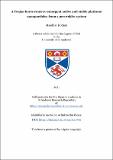Files in this item
A Trojan horse route to emergent active and stable platinum nanoparticles from a perovskite system
Item metadata
| dc.contributor.advisor | Irvine, John T. S. | |
| dc.contributor.advisor | Wails, David | |
| dc.contributor.author | Kothari, Maadhav | |
| dc.coverage.spatial | 171 | en_US |
| dc.date.accessioned | 2024-02-16T09:30:25Z | |
| dc.date.available | 2024-02-16T09:30:25Z | |
| dc.date.issued | 2021-06-30 | |
| dc.identifier.uri | https://hdl.handle.net/10023/29267 | |
| dc.description.abstract | Platinum (Pt), generally dispersed on a solid oxide support, has been widely used for catalytic chemical reactions in automobile, petroleum and energy industries. During the reactions, Pt is exposed to severe conditions, for example, heat and impurities, that cause Pt agglomeration and poisoning, respectively, resulting in activity/stability decrease. Here, perovskite materials are designed with Pt for significant catalytic properties through novel doping and exsolution methods. Perovskite structured materials (ABO₃) are selected because these are basically stable at heat and redox environments with coke/sulfur resistances at the catalytic or electrochemical conditions. When perovskite oxides are employed as supporting frameworks, certain catalysts like Pt can be incorporated as cations on the B site of the perovskite lattice under oxidizing conditions (doping). By tailoring the stoichiometry of the doped perovskite materials, the dopants can be partly exsolved as nanoparticles (NP) on subsequent reductions, which provides the possibility of the in situ growth of NP (emergence). This method can improve the catalytic property of Pt by less loading, proper size, high dispersion, unique active sites and strong bonding structure with the perovskite. Because only a few studies have been carried out due to the difficulty in the handling of Pt, the goal is to develop an innovative Pt perovskite catalyst to use in various catalytic applications. | en_US |
| dc.description.sponsorship | "Thank you to the EPSRC for an industrial CASE scholarship with Johnson Matthey."--Acknowledgements | en |
| dc.language.iso | en | en_US |
| dc.publisher | University of St Andrews | |
| dc.subject.lcc | TP245.P7K7 | |
| dc.subject.lcsh | Platinum | en |
| dc.subject.lcsh | Catalysts | en |
| dc.subject.lcsh | Automobiles--Pollution control devices | en |
| dc.subject.lcsh | Clean energy--Technological innovations | en |
| dc.title | A Trojan horse route to emergent active and stable platinum nanoparticles from a perovskite system | en_US |
| dc.type | Thesis | en_US |
| dc.contributor.sponsor | Engineering and Physical Sciences Research Council (EPSRC) | en_US |
| dc.type.qualificationlevel | Doctoral | en_US |
| dc.type.qualificationname | PhD Doctor of Philosophy | en_US |
| dc.publisher.institution | The University of St Andrews | en_US |
| dc.identifier.doi | https://doi.org/10.17630/sta/770 |
This item appears in the following Collection(s)
Items in the St Andrews Research Repository are protected by copyright, with all rights reserved, unless otherwise indicated.

